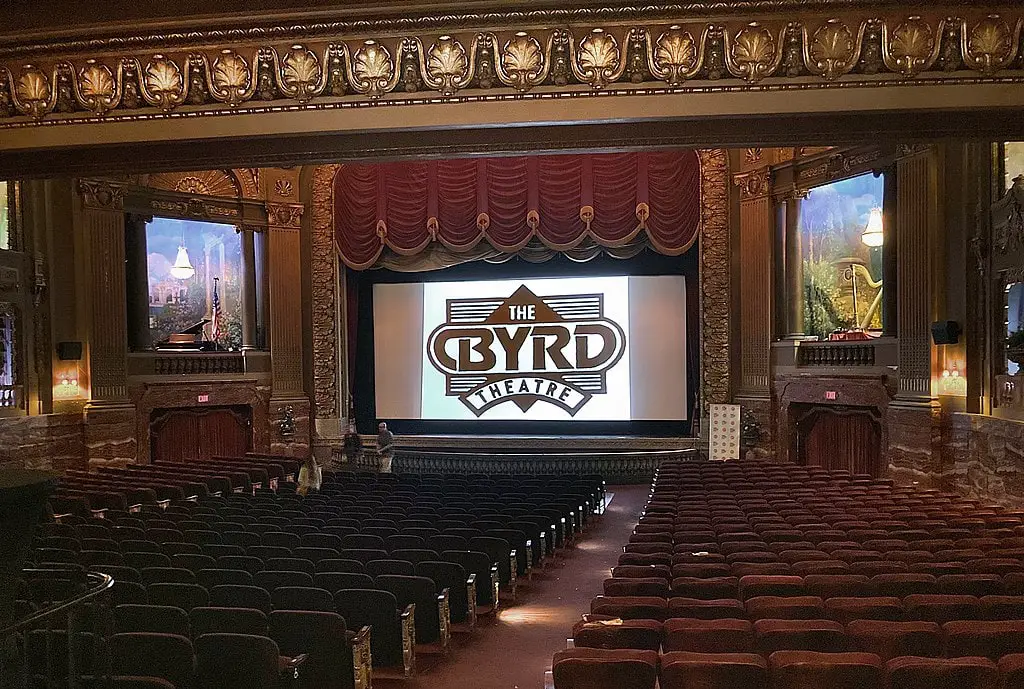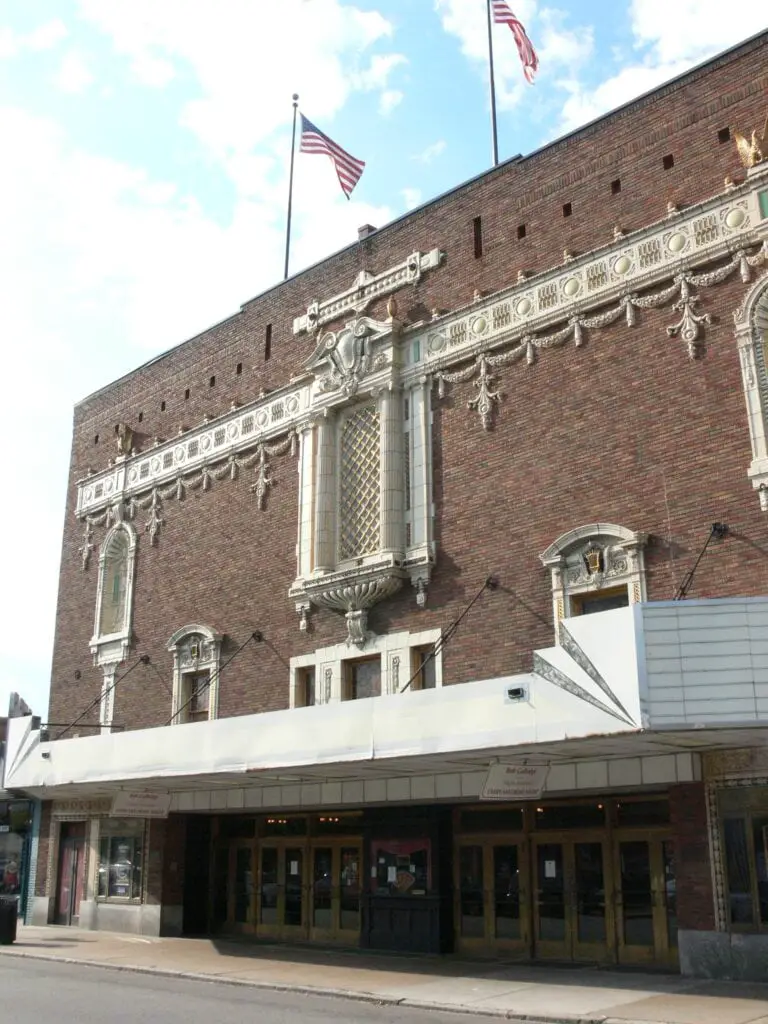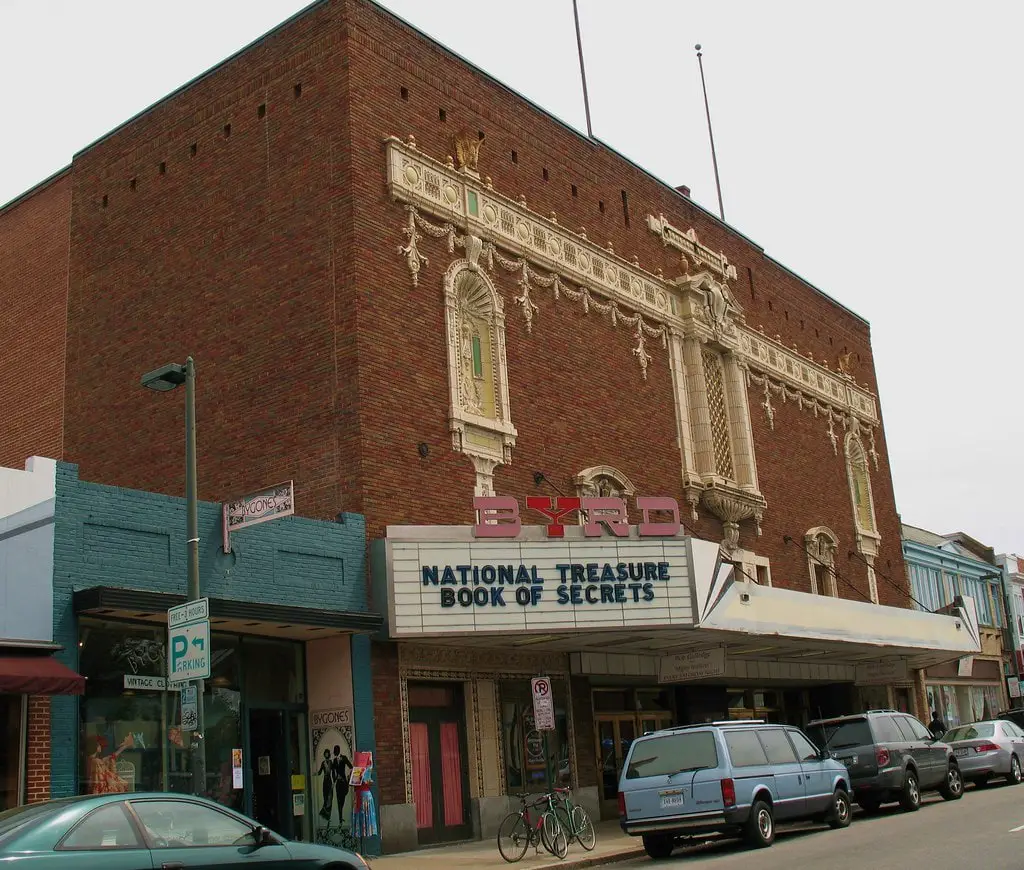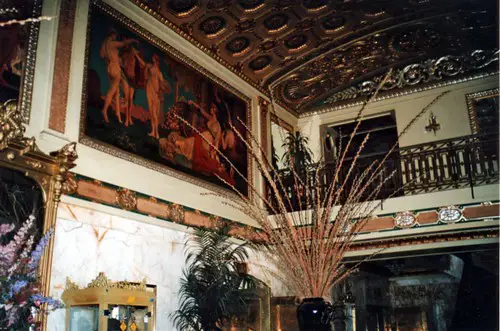The Grand Opening and Historical Significance
On a chilly December evening in 1928, Richmond, VA, witnessed the unveiling of one of its most cherished landmarks: the Byrd Theatre.
Named after William Byrd II, the city's founder, this cinema palace marked a new era in entertainment and architecture for the local community. I remember reading about the grand opening; the streets were abuzz with excitement as residents gathered to glimpse the luxurious new venue.
The Byrd Theatre's debut was a significant cultural moment. It opened its doors on December 24, 1928, offering a sanctuary for movie lovers during a time when cinema was rapidly evolving.
The first film to grace its screen was "Waterfront," a silent movie enhanced with sound, reflecting the industry's transition from silent films to "talkies." This shift was monumental, and the Byrd stood at the forefront, equipped with state-of-the-art technology.
The 1920s were a golden age for cinema and architecture, and the Byrd Theatre embodied both. The construction cost of $900,000 - a staggering amount at the time - represented a significant investment in the arts and entertainment sector. This wasn't merely a local theater but a statement of luxury, innovation, and community pride.
As years passed, the Byrd Theatre became more than a movie palace; it became a historical beacon for Richmond.
Its survival through decades of change is a testament to the city's resilience and dedication to preserving its cultural heritage.
Today, when I think about things to do in Richmond, VA, the Byrd Theatre always comes to mind as a piece of living history that continues to enchant and educate.
Architectural Marvels and Design
Walking through the doors of the Byrd Theatre feels like stepping back in time. The design screams opulence and grandeur, clearly reflecting the 1920s' architectural ambition.
Fred Bishop, the mind behind this masterpiece, chose the French Empire style. This decision set the theatre apart from its contemporaries. This wasn't just about creating a space but crafting an experience.
Every inch of the interior tells a story of luxury and attention to detail. The main auditorium, with its vast, open space, immediately draws the eyes upward to the stunning 18-foot chandelier.
This isn't just any light fixture; it's a beacon of craftsmanship, adorned with around 5,000 Czechoslovakian crystals.
The glow from 500 bulbs, alternating between red, blue, green, and amber, bathes the room in a warm, inviting light. It's a centerpiece that captures the essence of the era's extravagance.
But the Byrd's design marvels don't stop at the chandelier. The theatre is a treasure trove of artistic details, from the imported Italian and Turkish marble to the hand-sewn velvet drapes.
Arthur Brunet Studios from New York took charge of the interior decoration, bringing to life the mythological scenes that adorn the walls and ceilings. They're windows into a bygone era, each brushstroke a testament to the theatre's commitment to beauty and storytelling.
The choice of materials, the intricate designs, and the overall ambiance reflect a time when movie-going was a grand affair. The Byrd Theatre wasn't built just to show films but to offer an escape, a momentary journey to a world of elegance and fantasy.
As I think about the craftsmanship and care poured into every detail, I can't help but feel a deep respect for the visionaries who brought this cultural jewel to life.
The Byrd's Unique Features and Technological Innovations
The Byrd Theatre stands out for its stunning design, pioneering features, and technological advancements.
I've been fascinated by how this venue blended tradition with innovation, especially during an era of rapid change in the film industry.
One of the most remarkable aspects of the Byrd is its sound system. In the late 1920s, the transition from silent films to "talkies" was a major shift.
The Byrd was ahead of its time, equipped with two sound systems: Vitaphone and Western Electric.
These cutting-edge technologies ensured that the Byrd could deliver a top-notch auditory experience.
The Vitaphone system, developed by Warner Brothers, was particularly notable for its role in the success of "The Jazz Singer," the first feature-length movie with synchronized dialogue.
But what truly sets the Byrd apart is its Wurlitzer organ, a piece of cinematic history. Housed in four rooms above the stage, the organ was essential to the silent film experience, providing live music to accompany the on-screen action.
The organ's pipes, bells, drums, and effects create a rich, immersive sound that transports audiences back in time.
The fact that the Byrd still features live Wurlitzer performances today is a testament to its commitment to preserving the authentic movie-going experience.
Another innovative feature of the Byrd was its air conditioning system. Imagine, back in the 1920s, walking into a cool, comfortable theatre on a hot summer day.

The Byrd was one of the first buildings in the area to offer this luxury, thanks to a natural spring and pool in the basement that supplied water for the system. This was a bold step into the future of public spaces, setting a standard for others to follow.
The Byrd Theatre's blend of historical charm and technological innovation makes it a unique landmark. It's a living museum showcasing cinema technology's evolution and the enduring appeal of classic film experiences.
Segregation and Social Change
Like many institutions of its time, the Byrd Theatre mirrors a complex period in American history, particularly regarding segregation.
Learning about this aspect of the theatre's past opens a window into the era's broader societal changes and challenges.
It's a reminder that places of entertainment were not immune to the prejudices and policies that divided communities.
Initially, the Byrd adhered to the segregation norms of the South, a decision that, from today's perspective, casts a shadow over its storied past. The balcony, traditionally a place of lesser status, was designated for African-American patrons.
However, in a twist of irony, they were not even allowed entry until the 1960s. This policy reflects a painful chapter in Richmond's history, one that many other cities in the United States shared.
The shift in the Byrd Theatre's policies during the 1960s was more than a change in seating arrangements; it was part of a larger, tumultuous movement toward civil rights and equality.
The theatre's eventual desegregation didn't just open doors for African-American moviegoers; it symbolized a step forward in the community's journey towards inclusivity and understanding.

This change didn't erase the past, but it began a new chapter in the theatre's history that aligned more closely with the ideals of freedom and equality that the arts often strive to uphold.
Reflecting on this period of the Byrd's history is uncomfortable yet necessary. It reminds us that progress often comes slowly and with struggle.
The theatre's evolution from a segregated space to a welcoming venue for all is a testament to the power of community advocacy and the ongoing fight for civil rights.
It serves as a reminder that while we can appreciate the beauty and nostalgia of historic places like the Byrd, we must also acknowledge and learn from their more troubling histories.
Preservation Efforts and Community Involvement
The Byrd Theatre's journey from a grand movie palace to a cherished historical landmark is a story of community spirit and dedication.
The preservation efforts for this Richmond gem highlight the city's commitment to its cultural and historical heritage.
Seeing how the community has rallied to maintain and restore the theatre is inspiring, ensuring it remains a vibrant part of Richmond's landscape.
In 2007, the Byrd Theatre Foundation, a non-profit organization, made a move by acquiring the theatre. This move was more than a transaction; it was a pledge to protect and preserve a piece of Richmond's soul.
The foundation's mission resonates with me: they're safeguarding a piece of history, ensuring that future generations can enjoy and learn from it.
The foundation's work is extensive, covering everything from essential repairs to more extensive restoration projects.

For instance, they've replaced the roof and updated the heating and cooling systems, which are crucial steps to protect the building from decay and ensure visitor comfort. But what really stands out to me is the community's involvement in these efforts.
Fundraising campaigns and donations reflect the deep affection residents have for the Byrd. It's a testament to the theatre's role in the community as a shared space where memories are made.
Preserving the Byrd Theatre is an ongoing journey that requires time, money, and love. But it's clear that the Richmond community is up for the challenge.
The theatre's survival and revival are shining examples of what can happen when a community comes together to support something they cherish. They remind us that while buildings may age, their stories and memories remain timeless.
The Byrd Theatre Today: Films, Festivals, and More
The Byrd Theatre today stands as a beacon of culture and history in Richmond, VA. It's fascinating to see how this historic venue has adapted to the times while maintaining its classic charm.
The theatre now offers a mix of second-run movies, special events, and unique film festivals, making it a vibrant part of the community.
A standout event on the Byrd's annual schedule is the Richmond French Film Festival, which takes place every March.
This event transforms the theatre into a hub of international cinema, showcasing the richness of French filmmaking.
It's an immersive cultural experience that brings a piece of France to Richmond. The festival's success is a testament to the Byrd's ability to bring diverse programming to its audience.
But the Byrd isn't stuck in the past. In recent years, it has embraced modern technology while preserving its historical essence. The installation of a Dolby Digital sound system, donated by Ray Dolby himself, is a perfect example.

This upgrade enhances the viewing experience without compromising the theatre's vintage atmosphere. It's a delicate balance, but the Byrd manages it beautifully.
The theatre's role in the community extends beyond showing movies. It's a place where memories are made, history is alive, and the arts are celebrated.
The Byrd Theatre continues to be a place where people from all walks of life can come together to enjoy the magic of cinema. It is heartwarming to see how this historic venue has remained relevant and beloved in today's fast-paced world.
The Byrd's legacy as a cultural beacon in Richmond seems secure, thanks to the collective efforts of its supporters and the broader community. Its continued success hinges on engaging new audiences while honoring the traditions that make it unique.
As someone who values history and community, I believe the Byrd Theatre will continue to be a place where past and present coexist harmoniously, offering rich experiences to all who walk through its doors.
